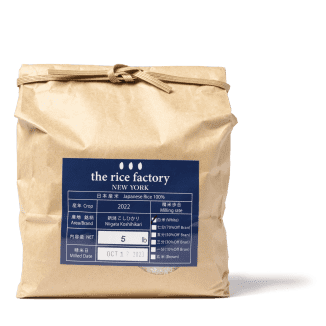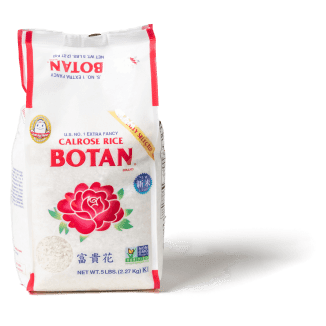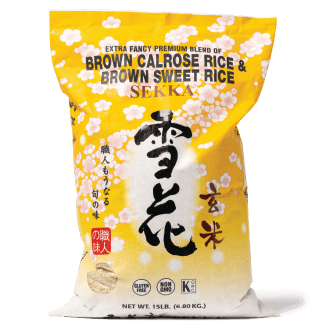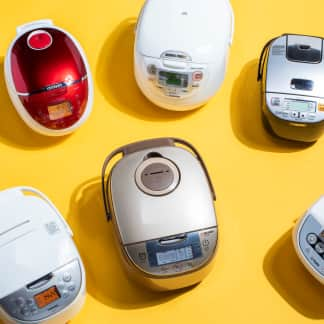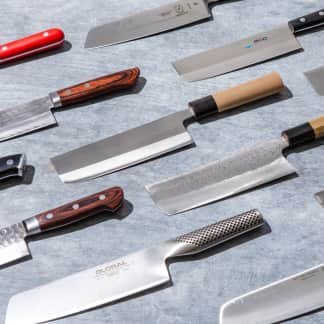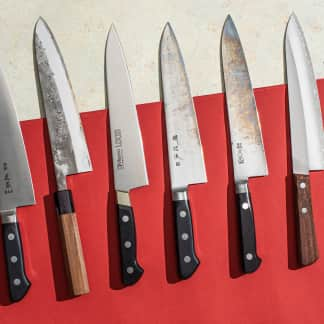Short-grain rice is sometimes sold as “sushi rice” in America. But to tout only its wonders in sushi is selling this rice, well, short. This style of rice, when served as a side dish to accompany vegetables and proteins, is called “uruchimai,” or “table rice,” in Japanese.
Most of the so-called “sushi rice” in America is a variety called Calrose, grown in California. It’s part of a broader family of rice called japonica, a style known for short, squat, sticky grains. Other types of rice, including arborio and Bhutanese red rice, are part of this family and have rich histories and culinary traditions. But for this story we wanted to investigate a trend we’re seeing. Japanese-style rice grown in and imported from Japan is becoming increasingly popular in the United States, and we wanted to learn more about this growing category. For brevity’s sake, we’ll refer to it as Japanese rice going forward, regardless of where it’s grown.

Circana, a Chicago-based market research firm, helped us identify the top-selling products in the United States. Culinary experts, historians, and authors helped us round out our lineup with smaller artisanal brands. We ended up with 19 short-grain varieties, a combination of white rice, brown rice, and a sweet variety called mochigome. Some were supermarket standbys, such as Kokuho Rose and Nishiki, while others were specialty products ordered via online retailers. We included Calrose as a point of comparison because it’s the best-selling brand of this kind of rice in the United States.

Test kitchen staffers and Japanese American chefs and restaurateurs evaluated each rice on flavor and texture. From pearly, luscious Koshihikari to sticky-sweet mochigome, we saw a category with more breadth and depth than “a plain bowl of rice” may imply. We dug deep to learn more about the history of Japanese-style rice, how it’s grown and processed, and which products stood out as must-trys. Read on to learn more.
Short-Grain Rice’s Long Journey
The first rice in East Asia, also known as Oryza sativa L., was cultivated in China and then spread to Korea and on to Japan, emerging on the southern island of Kyūshū as a new subvariety called Oryza japonica. The exact timing is murky, but Eric Rath, food historian and author of Oishii: The History of Sushi (2021), said rice arrived in Japan three to four thousand years ago. In the 1880s, some of these japonica varieties made their way to the United States to feed Chinese railroad workers in California, according to Robin Koda, third-generation rice farmer at Koda Farms.

Calrose, the most popular variety of Japanese-style rice in the United States, was developed in the early 1900s and released in 1948. Other interesting evolutions of japonica have emerged stateside, such as Kokuho Rose, a crossbreed of a Persian long-grain and a short-grain rice, launched in California in the 1960s. Nishiki, a hybrid of Kokuho Rose and M-401, a medium-grain rice variety, was released in California in 1981. (California is the number two rice-producing state in the United States, behind only Arkansas, where long-grain rice dominates.)
Agriculture in general has a strong history of crossbreeding to create strains with different qualities, and rice is no exception. Due to crossbreeding with longer varieties, the California rice tended to have longer grains than the Japanese varieties in our lineup. However, the terms “short-grain” and “medium-grain” are not regulated, so you may see both California- and Japanese-grown rice labeled with these terms. All of the rice we tasted was shorter in length than long-grain varieties such as basmati or jasmine.
Milling Rice: A Customizable Option Emerges Stateside
All white rice starts off as brown rice, including Japanese-style varieties. After harvesting, the hulls of the rice kernels are removed and grains of brown rice emerge. To produce white rice, the germ and bran that give brown rice its color are polished away by a machine process called milling. Mochigome rice starts with a purple or red-colored outer hull that is then milled away, revealing pearly white grains.
In Japan, customized milling is common—dialing in the exact percentage of bran and germ removed so that “the resulting grains retain both the characteristics of brown and white rice,” according to Jun Mattison, assistant manager of The Rice Factory in Scarsdale, New York. This allows you to balance the hearty, nutty notes of brown rice with white rice’s soft texture and sweet flavor to your exact preference. The Rice Factory’s mills, like many of those in Japan, can remove anywhere from 10 to 100 percent of the bran, depending on the customer’s preference.
Though such customization isn’t commonly available in the United States yet, there’s a growing interest among rice connoisseurs, and specialty shops such as The Rice Factory ship custom-milled rice.
Most of what you find in stateside stores and online has had either all of the bran (white rice) or none of the bran (brown rice) removed.

Shopping for Japanese Rice
We’ve listed the varieties we tried (Japanese imports first, followed by American-grown options) with tasting notes, noting our favorites to try in each category. Look for them at stores such as Maruichi, 99 Ranch, and H Mart, as well as online from The Rice Factory, Nijiya Market, and even Amazon. If you’re interested in custom milling, check out The Rice Factory.
White Rice We Tasted
Type: | Type:  Koshihikari Koshihikari | Type: 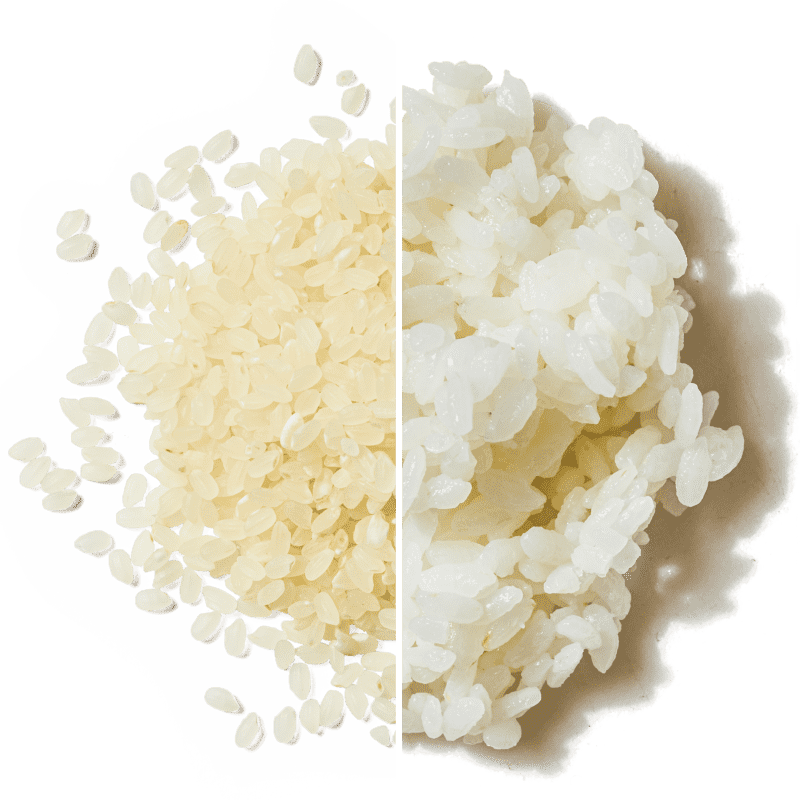 Sasanishiki Sasanishiki | Type:  Yumepirika Yumepirika | Type:  Kokuho Rose Kokuho Rose | Type:  Nishiki Nishiki | Type:  Calrose Calrose |
|---|---|---|---|---|---|---|
Description: | Description: One of the best-known varieties developed in Japan, it’s widely available and a great option for people who want to experience the nuances of short-grain rice. We were impressed by its shiny, pearly appearance and buttery fragrance. We liked the luscious look and subtly sweet aftertaste of The Rice Factory Niigata Koshihikari; we also enjoyed the bouncy chew of Tamaki Gold California Koshihikari Short Grain Rice. | Description: Sasanishiki is a pillowy, soft rice developed in Miyagi, Japan. The Rice Factory Miyagi Sasanishiki rice had a glossy finish. Each grain remained distinct with a chewy texture. We were impressed by its delicate aroma and neutral, mildly nutty flavor. | Description: This fragrant rice is plump in texture. The Hokkaidӧ Yumepirika impressed us with its shiny, glossy appearance. Many tasters noted a buttery and floral fragrance, springy chew, and nutty flavors. | Description: Koda Farms developed this medium-grain strain in the 1960s in California by combining a Persian long-grain and a short-grain rice. The proprietary Kokuho Rose rice grown by Koda Farms that we tasted was oaty and creamy; the version from Nomura & Co. (called Kokuho Rose Japanese Style Rice), which grows a more recent descendent of the variety, was buttery. | Description: Nishiki (also the brand name) is a hybrid of Kokuho Rose and the M-401 strain, a medium-grain rice variety developed in California. It’s similar to Calrose rice in appearance, texture, and flavor. The grains are longer and we liked their moderate chew. | Description: A medium-grain rice developed in California, it’s often sold as “sushi rice” at supermarkets. Botan Calrose Rice was sticky and soft; Sushi Chef rice had a nice chewy texture. |
Brown Rices We Tasted
Type: | Type:  Yukinoho Koshihikari Yukinoho Koshihikari | Type:  Nishiki Nishiki | Type:  Sekka Sekka |
|---|---|---|---|
Description: | Description: This is the brown rice version of a popular white rice that we loved. We tasted one from Minamiuonuma City in Japan's Niigata Prefecture. Our tasters liked its firm, pleasant chew, which offered a good snap. A subtle creaminess came through for a rice that was pleasantly nutty, sweet, and earthy. | Description: Compared to the polished white rice version, this brown rice was a little chewier and firmer but not tough. The Nishiki brand was deeply nutty and earthy. We even noticed a lingering caramelly flavor. | Description: Sekka is a variety of medium-grain rice grown in California; we tasted one sold by Shirakiku. It was firm, offering a pleasant chew. It had a deeply nut-forward flavor, followed by roasted rice notes and a sweet, floral aftertaste. |
Mochigome We Tasted
Type: | Type:  Shirake Shirake | Type:  Sho-Chiku-Bai Sho-Chiku-Bai |
|---|---|---|
Description: | Description: This variety of sweet rice hails from The Rice Factory’s farm in Nagano, Japan. It’s delightfully sweet, nutty, and floral, and its texture is sticky, tender, and chewy. Both its subtly sweet flavor and chewy texture reminded tasters of plain mochi. | Description: A variety of California-grown sweet rice from Koda Farms, its production predates the company’s flagship Kokuho Rose variety. Our tasters liked the glistening shine of Koda Farm’s Sho-Chiku-Bai and enjoyed its earthy and mildly sweet flavors in sekihan. The texture was sticky and chewy. |
- Taste most varieties plain, rinsed, and prepared in a rice cooker
- Taste mochigome (Japanese sweet rice) in sekihan (Japanese red bean rice) prepared in a rice cooker

